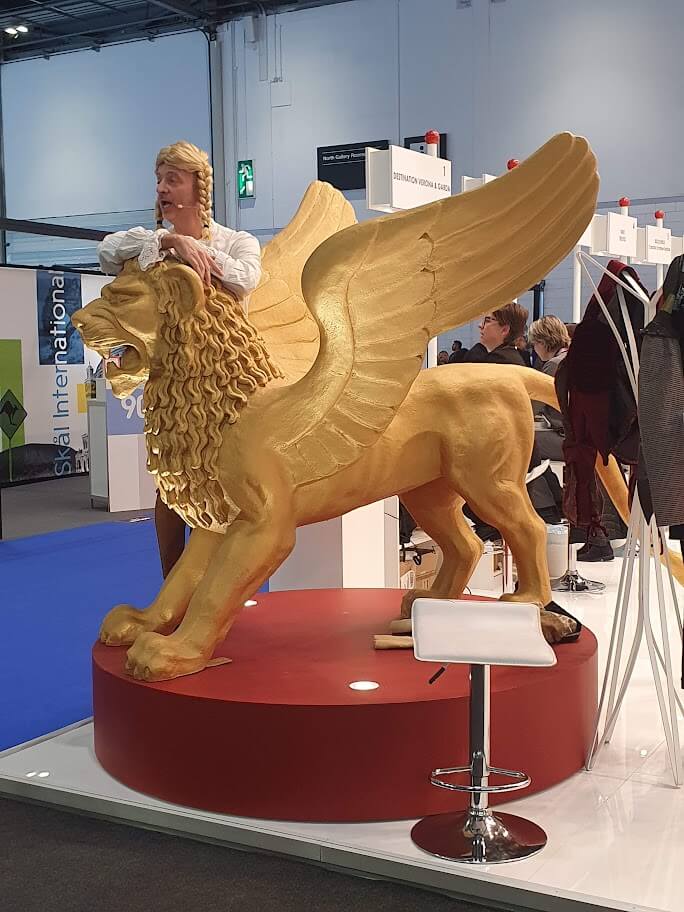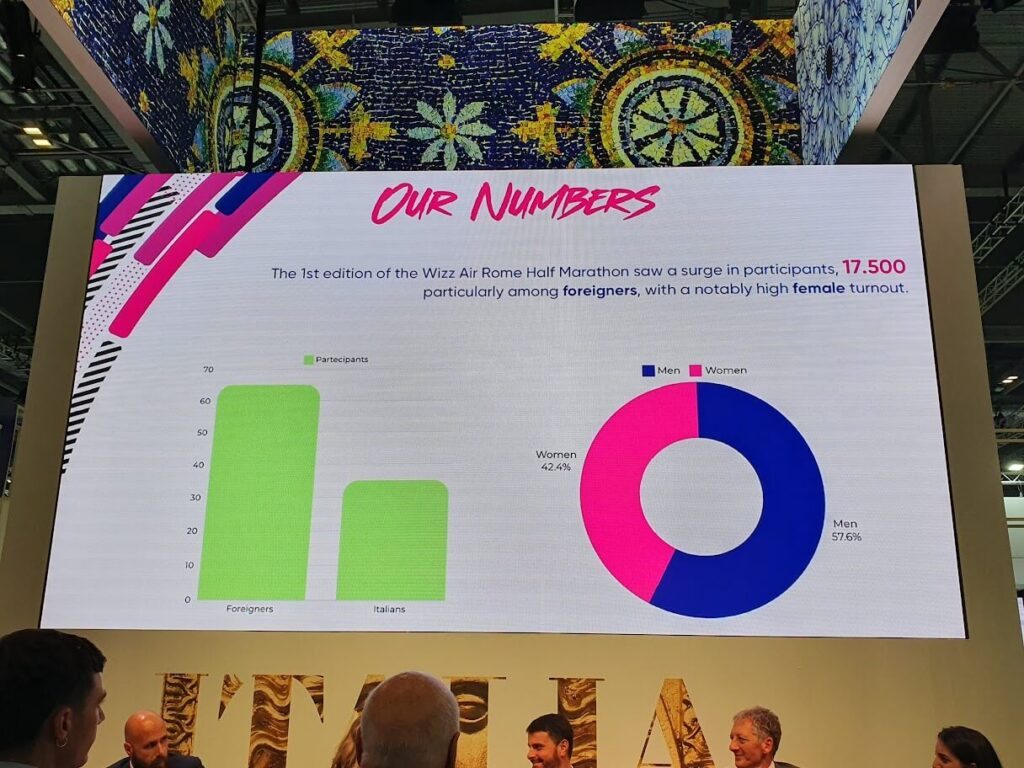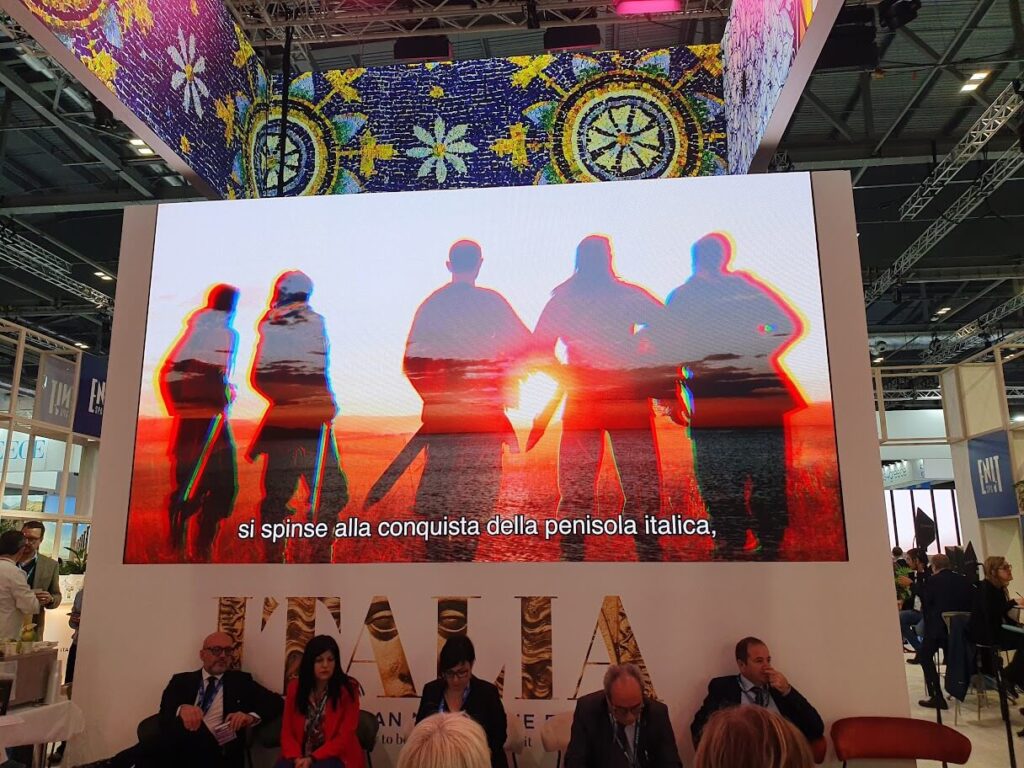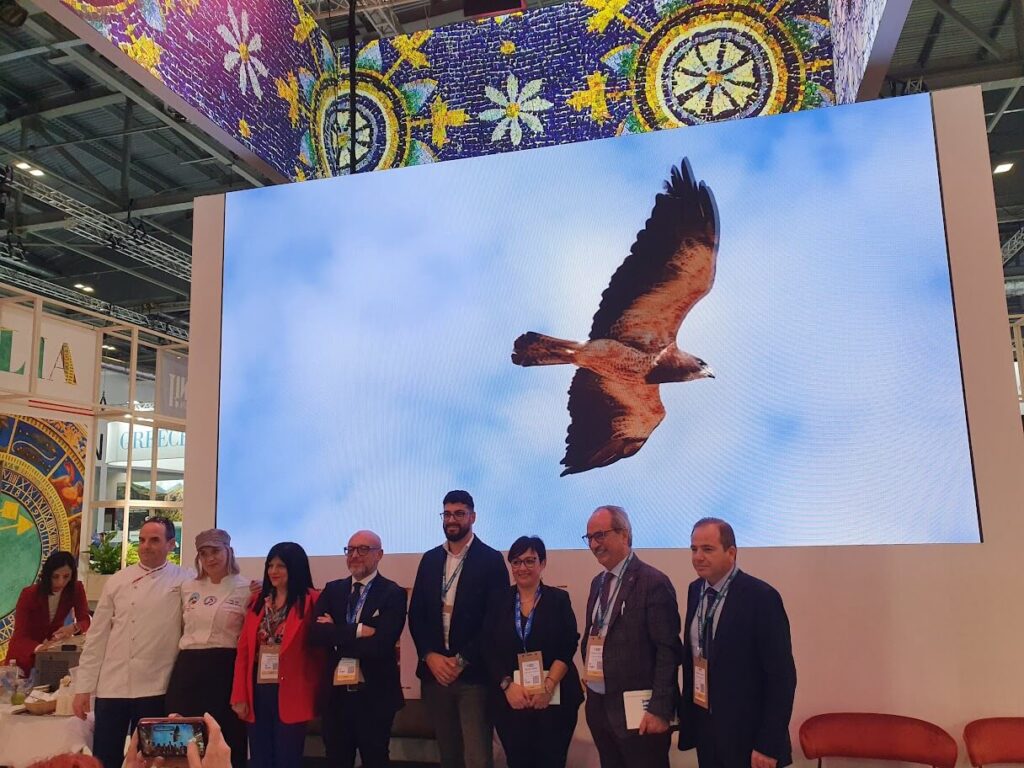Last week I attended the World Travel Market (WTM) in London, a huge travel industry event where tourism boards, travel operators and businesses hope to make connections, market their regions or services and hopefully catch the attention of the media. Italy’s national and regional tourist boards invest a lot in the event; this year there was great pride in the scale of the Italian stand; the largest one present.
From the pomp of the inauguration of Italy’s stand – Ambassador, Tourism Minister, ribbon-cutting, but thankfully no showgirls like last year – to the press presentations of micro-regions, I noted common themes as well as ideas for my own future research trips and updates. One of the main concerns worldwide, addressed through the whole event, was of course overtourism. Everyone’s read about the new tourist entry fee in Venice and seen photos of protests in Spain. You may have seen articles about recent attacks on Airbnb keysafes in Rome, and you’ve probably paid city tax in Italian hotels.
What are Italy’s strategies for dealing with overtourism? Does the country even still want you to visit? Tourism Minister Daniela Santanchè opened the event and at once raised an objection to using the word ‘overtourism’. And subsequent press conferences followed suit. Italy is a hospitable country with a hospitable culture – and tourism is very important to the economy. Tourism is the gold of Italy, the minister told us. The Italian tourist trade is understandably wary of discouraging visitors or making them feel unwelcome.
No-one can deny there is a problem, not if you’ve experienced those peak-season crowds in small locations or watched the changes over the years in a popular destination like Venice. But the talk at WTM was not of problems but of solutions. (Well, since there was no overt raising of a ‘problem’, let’s call them alternatives).

Extending the tourist season
The keyword for the first strategy, which ran through every Italian press conference, was destagionalizzazione (even the native Italian speakers struggled over that word occasionally). Basically it means ‘de-seasonalise’. By spreading visitors through the year, destinations are hoping for two good results: alleviating overcrowding in the peak summer months (optimistic!), and lengthening the tourist season to include spring, autumn and winter too, with all the benefits that will bring to local economies.
Some destinations are already set up for winter tourism. For example, the ski resorts of Piemonte, present at WTM and proud of the big winter sports events coming up soon including the Winter World University Games. Before the pandemic Rome and Venice had become winter targets for large-group tourism from China. A former Rome resident, I was actually shocked at the crowds in Rome in the last pre-Covid winter. I still maintain that winter is a great time to visit those cities, though, especially Venice: Winter in Venice. Elsewhere, other regions would like a bite of that cherry.
Sicily, with its mild winters, has the objective of “365 days of tourism”. Their fourth largest market is British travellers, drawn, we are told proudly, by culture and food (I can’t argue with that). The region’s smaller islands, while hampered by scarcer and less reliable ferry connections in winter, offer different colours every month of the year; Lampedusa has year-round flights and other islands maintain ferry connections. Opera houses in Catania and Palermo can add a cultural element to a visit outside the peak summer months; I enjoyed the passionate eulogy to the power of live performance from the Superintendent of the Teatro Massimo Bellini in Catania, Giovanni Cultrera (and as an opera-goer I doubly appreciated his marketing of opera as time to turn off your phones).
Events are seen as a key to attracting and entertaining visitors at quieter times of year. Rome’s annual marathon (next one: 16th March 2025) and half-marathon (19th October 2025) are examples of events which are drawing increasing numbers of international participants. Combining running with sightseeing (quite literally, the routes are planned to show off Rome’s ancient attractions) offers the kind of opportunity at which Italy is almost unmatchable.
Special festivals and spectacles aim to make a midwinter break more enticing: WTM audiences were told of Christmas light displays on Lake Maggiore and Lake Orta islands (Isole di Luci) and plans for a new winter-edition festival in Gerace, Calabria. Among Italy’s great local spectacles is one I’ve always wanted to attend, the Macchina di Santa Rosa in Viterbo (Lazio) each September, and a dramatic video of the build up to this event was shown at a Lazio press conference making me even keener.

Sharing out the visitors: getting off the beaten track, borghi and experiences
The second big strategy for managing tourism levels is one that my readers will already be on board with, but which the professionals at WTM call directing tourism flows. There is a lot of talk of ‘flows’. Italy would like to spread its visitors outside the crowded honeypots and towards less-visited destinations in the surrounding areas, as well as further afield.
Getting off the beaten track is of course, an absolutely great idea for travellers, and always has been. It’s good to hear the other side of this: why Italy, its tourism boards and those overlooked destinations want us to explore beyond the tourist trail. They may be preaching to the converted, but the goals, inducements and initiatives discussed are pretty interesting.
Rome and the Vatican City are expecting 35-40 million visitors in 2025 for the Jubilee Year. So who wouldn’t want to get out of town? In a press conference offering presentations for several Lazio micro-regions, we were offered convincing cases for exploring the region. Slogan: ‘All roads lead to Lazio’. An idea close to my heart, since I originally started www.italyheaven.co.uk when I lived in Rome and was exploring the region, sharing practical travel information about some of these same destinations.
A spokeswoman for Ospitalità Castelli Romani invites travellers to stay in these charming hills just outside the city with the caption “Very close to Rome: you can see it from Rome”. I spent their video presentation somewhat distracted as I mulled over whether the depiction of a woman roaming the area was a continuation of the use of attractive women as marketing objects, which had been irritating me around the trade show, or whether it was a positive view of active solo travel (video-lady was more excited at a library than even I would be, she hiked and paddle boarded – in a skimpy bikini – and then found a handsome man in a vineyard to share a romantic dinner, so there was a lot to consider; on the whole, I decided, it worked). Anyway, critical video analysis aside, the push to capture some of Rome’s visitors was the main context here. I like the Castelli Romani; I’d definitely suggest staying here for a few days if you have a car and/or fancy slow travel, though if you want to do much sightseeing in Rome I’d make it a two-centre holiday rather than commuting in repeatedly.
Combining realism and pragmatism, some tourist boards don’t expect their visitors to abandon the traditional honeypots. The Piemonte region explains that they would like their well-heeled British and American guests, who might typically stay three nights in an expensive Lake Maggiore hotel, to add in an extra two nights elsewhere in the region, among its small historic wine towns, maybe (a delicious glass of pink Bracchetto made an excellent inducement).
Sicily is blessed with many small historic destinations which aren’t over-touristed. These borghi (a useful Italian word for small historic towns and villages, often fortified and on hills) are often suffering depopulation – hence those €1 house initiatives. Hopes are expressed here that tourism, and particularly ‘de-seasonalised’ tourism, might help bring these to life and encourage younger locals to remain. The Vie dei Tesori (Streets of Treasures) festival every autumn is an initiative which opens many of the island’s doors which are normally closed to local visitors and tourists alike. A spring edition is entitled Borghi dei Tesori.
In fact, borghi might be a third keyword for the Italian tourist strategies on display at WTM. These smaller, charming destinations, usually picturesque and often with a fascinating history, offer great experiences (another current buzzword) to visitors, are full of authentic local atmosphere, and most are keen to welcome ‘quality’ tourism. These are the destinations among which Italy would like to see those ‘tourism flows’ dispersed. I love these less-visited places and you’ll find a lot of them on this website, from the north to the south of the country. My favourites include Asolo in the Veneto, Brisighella in Emilia-Romagna, and Savoca in Sicily, two of which I was very pleased to get featured on a BBC travel series for which I was a consultant.
Another fine borgo, featured two years in a row at WTM and very pro-active in seeking visitors, is historic Gerace in Calabria. I enjoy the fact that their chosen ambassador in video, storytelling and AR tours is not a skimpily-clad woman but beardy chainmail-clad warrior Roger the Norman (watch the video and smile). Gerace’s tourist offering is all about history, people, crafts and experiences. It’s been on my to-visit list for a while but the presentations and enthusiasm have pushed it higher on the list.

In conclusion: what does it mean for travellers?
The good news for travellers worrying about overtourism and the impact of their holidays in Italy is that you have the chance to be the solution and not the problem. And readers of my website, who may have found your way here because you’re already interested in the off-the-beaten-track destinations, and the quieter, quirkier towns, are exactly the kind of tourists who Italy is keener than ever to attract right now.
North European and English-speaking tourists were mentioned a lot at WTM. With a tendency to be relatively high-spending, open to visiting during shoulder seasons, and interested in cultural sights and experiences, we are generally welcome visitors. ‘Quality not quantity’, said the Tourism Minister, and most of us would rather be thought of as a sought-after visitor than part of a problem. It’s good to have this reinforcement of Italy’s ideal of engaged experience-seeking travellers heading off the beaten track and considering out-of-peak-season journeys. If you’re starting to think about 2025 travel, there may some food for thought and quite likely some encouragement in this.


Reflections on the ethics of travel
It’s obvious that there are not any easy solutions to the impact of tourism, other than not to travel, and I do consider frequently the ethics of my own job. I fear that the tourism longed for by those attractive small destinations could become a poisoned chalice, particularly after visiting crowded little Polignano a Mare last summer. At WTM everyone, like me, works in the travel business so is not there to discourage travel. Not every resident of Italy does benefit directly from tourism, though, and the impact of tourism on the environment, on local communities, and on property prices is a difficult issue with no perfect solution to suit everyone plus the planet.
There are other important aspects of sustainability in travel which haven’t been covered here, especially the environmental impact. Obviously choosing land travel rather than plane travel is preferable where you can do this. If you travel less often and stay for longer, that’s another way of keeping environmental impact down, though of course that isn’t feasible for everyone. Once in Italy I always use public transport to get around, and include transport information on my destination pages. Car-free travel in Italy can take some planning but is a relatively straightforward way to reduce your footprint. There is a lot to think about when considering travel.
